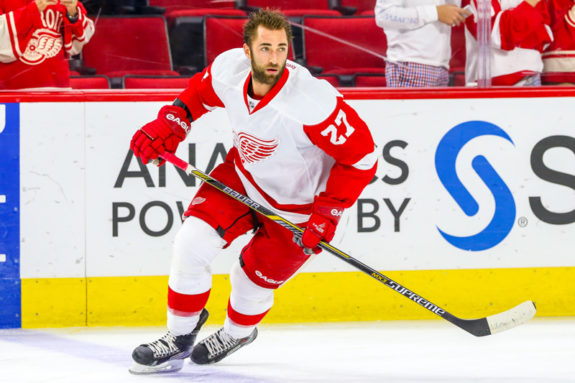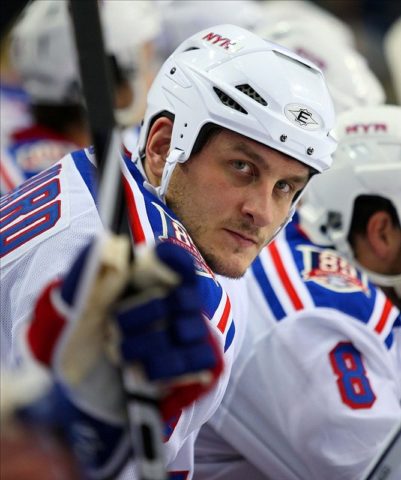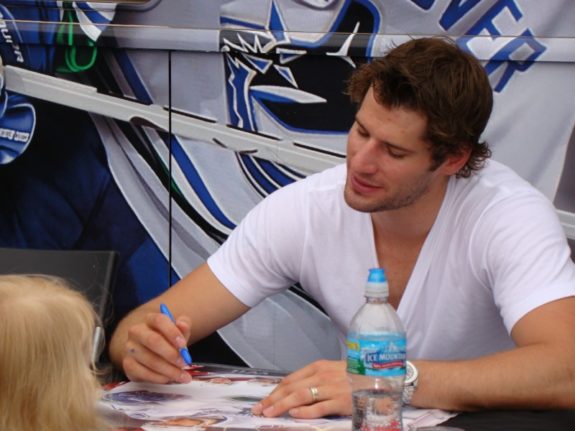In major professional sports leagues, performance-enhancing drugs and sometimes players’ struggles with illicit drugs have been the stuff of many gripping stories. Who could forget the BALCO scandal involving the use of banned steroids in Major League Baseball? And then there are the tragic stories of athletes whose careers and sometimes their lives were brought to a tragic end by booze, cocaine, fentanyl and all manner of other drugs that people take to deal with their problems.
Related: Addiction & Substance Abuse in the NHL – It’s Bigger Than the Game
Yet what flies under the radar in professional sports leagues, including the NHL, is the overuse and abuse of prescription pain killers. It’s pro hockey’s dirty little secret – poorly documented, frequently talked about and devastating to the health of many NHL players – both during their careers and long after.
The Hockey “Code” and the NHL’s Problem With Pain Killers
For many, hockey the way it was meant to be played is set out in the mythical “Code”. One of its commandments is that players must play through injuries. True hockey players are warriors who find a way to play – no matter how much pain they’re in. And when they do, they are adored by their teammates, their fans and the media.
Tough guy Nick Boynton who retired in 2011 after 11 seasons in the NHL explained where that creed ultimately led for him when he opened up about how his addiction to sleeping pills and painkillers began. As he put it, “I was a fighter, a thug. I tried to hurt people. That’s what I was there for. I would try to injure you if that was the difference between winning and losing a hockey game. I’d do whatever was asked of me.” Yet Boynton never liked his job. “In truth,” he said, “I absolutely hated to fight. I was scared to death of fighting. On the nights before we played, I wouldn’t be able to get any rest. I’d be lying on a bed in a hotel room in Buffalo or Calgary or wherever, just kind of nervous and on edge … worried about what was going to happen to me out on the ice the next day.”
And that’s how he developed his dependence on sleeping pills. It was a way to manage his anxiety about fighting and his fear of getting hurt. Yet he did get hurt – constantly. “I was always hurting”, he said. “And in order for me to carry on, I had to mask all that pain. At one point during my career, I was taking so many painkillers and other drugs on a daily basis that I started to not even be able to recognize the person I had become. Trainers always had painkillers. So I took them. Often. And it just escalated from there. Eventually I couldn’t get as many as I wanted, and so I started buying them from people on the street. Just more and more and more.”
In Boynton’s day, prescription opioids, most frequently Oxycodone, were the NHL’s drugs of choice to deal with pain. Yet they were highly addictive and Boynton was just one of a long list of NHLers who eventually came to abuse them.
Not only that, but after his career he went on to develop serious problems with illicit drugs and alcohol. As he explained it, “By the time I finally started getting help for everything I had been doing to try and ease the pain, I was already in my 30s. And at that point I was basically drinking and self-medicating and doing drugs nonstop. I stayed away from heroin, but other than that, everything else was pretty much fair game.”
Still, Boynton is lucky – he’s alive today to talk about his battles with addiction. There is a long list of players who dealt with their injuries during their playing days with team-prescribed painkillers who went on to develop substance abuse problems that eventually killed them. Perhaps the best known are Derek Boogaard (accidental death in 2011 from an overdose of Oxycodone and alcohol), Wade Belak (apparent suicide in 2011 after a well-documented struggle with drug abuse) and Jimmy Hayes (apparent overdose of fentanyl and cocaine in 2021).
Toradol – The NHL’s Pain Drug of Choice
Being tough is vital in a sport like hockey where almost all players live with injuries and its resulting pain. This was well documented in TSN’s powerful 2020 documentary – “The high cost of painkiller abuse in professional hockey”. As former tough guy Kyle Quincey put it in the documentary, “Nobody can play in the NHL and not be tough. From the youngest age, you’ve been taught to play through things and to miss a game you’d have to be really debilitated. It’s hard to make it to the NHL and it’s even harder to stay there. You see the younger kids coming up trying to take your job, so you do what it takes.”

Now, instead of oxycodone-based painkillers, many NHL teams prescribe Toradol – a non-addictive, anti-inflammatory drug that reduces the hormones that cause inflammation and pain in the body. The problem with the drug is that neither the US Food and Drug Administration nor Health Canada has approved it for long-term use and both warn that it should not be used beyond five days. Yet Quincey took it every day toward the end of each season explaining that there was “no way I could get through the season without it. It masked all the pain, never messed with your head and you could literally run through a wall and not feel it.”
According to Toronto nephrologist Phillip Marsden, misuse of Toradol has been linked to serious side effects including stomach, liver and kidney complications. In Ryan Kesler’s case, the drug-induced colitis and Crohn’s disease – serious life-long conditions from which he’ll never recover and that have greatly diminished his quality of life.
According to Kesler, the use of prescription painkillers in the NHL is widespread. He says, “Players can lie about this, but every single player in that locker room is on a pain killer – anything that can help limit your pain and get you on the ice to play. I knew I had to play. To play, you gotta take painkillers because if you don’t do that, you’ll be labelled as a guy who doesn’t battle through injuries.”
Despite the grave risks posed by the misuse of Toradol, Kesler says that no team doctor ever explained to him the consequences of his overuse of the drug. Even so, it seems that team doctors and trainers aren’t the only ones who don’t talk much to players about Toradol.
The NHL and the National Hockey League Players Association (NHLPA) established the NHL/NHLPA Prescription Medication Subcommittee and its work is shrouded in secrecy. It meets only once per year to review monthly painkiller prescription reports compiled by team doctors. The content of the reports is a closely guarded secret. What’s more, nobody except the NHL and the NHLPA knows who sits on the committee.
Prescription Pain Killers and the NHL’s Business
At first blush, prescription painkillers appear to be good for the NHL’s business and its players. Without them, and especially without their abuse, many of the league’s best players simply couldn’t play. And because they help injured players perform night after night, these drugs help sell tickets. Yet this is a Faustian bargain that exacts a terrible price from players and may yet prove very bad for the NHL’s business.
The hockey world seems determined to sweep the problems wrought by prescription painkillers under the rug. Perhaps no one knows that better than Justin Rothlingshoffer, a personal trainer with several NHL players as clients. From 2017-19 he was the strength and conditioning coach for the San Diego Gulls – the American Hockey League (AHL) affiliate of the Anaheim Ducks.
According to Rothlingshoffer, he tried to introduce alternatives to prescription painkillers and it cost him his job. The Ducks accused him of administering and distributing cannabidiol (CBD) – a non-psychoactive derivative of marijuana. As he explained it, the NHL, “wants you to stay in your lane – no matter your education, no matter what you do outside, no matter what your intention. Know that your allegiance lies with the staff and management (of the team) before the player.”
It’s not just trainers and medical staff who are seemingly muzzled by the NHL should they raise questions about the use of prescription painkillers. Boynton recalled how he asked one of the NHL teams he played with for help in dealing with his addiction to prescription painkillers and other drugs. Initially, he said, “Everyone I talked to was so understanding. Every single person said they were there for me, and that they wanted to get me the help I needed.”
Less than a month after he’d gone to his team and asked for help, he was traded. For Boynton, the lesson was clear. As he explained it, “I took the hint, you know what I mean? From that point on, no matter how bad it got, I kept my damn mouth shut about any problems I was having off the ice. I asked for help, and I got shipped out. I just clammed up after that and went back to getting punched in the face and smashed in the head and not saying anything about what it was like to deal with all the pain I was feeling.”
Yet the league stands accused of more than just strong-arming team staff and players into staying silent about the overuse of prescription painkillers. Former players accuse the NHL of deceiving young players about the dangers of them.
When asked whether anyone had ever explained to him what the potential consequences of painkillers could be, Quincey laughed and said, “Never. Zero education and zero knowledge. No one is telling us what this pill does.” For him, part of the problem is that many younger players are often naïve. Quincey says that just as he did as a 23-year-old prospect, many of them, “just assume with that blind faith that they (the team) have your best interests in hand, when they have their own in hand.”
19-year NHL veteran Ryan Smyth echoed Quincey’s take in a 2022 Missin Curfew podcast (comments starting at 1:10). Reacting to Robin Lehner’s comments about the rampant use and abuse of pain killers in the NHL, he explained, “that over the course of my career there were guys that unfortunately got addicted. We lost a couple of teammates. There’s a lot of addiction. This is a serious thing. This is not something that is going to be swept under the rug.”
Part of the problem in Ryan’s view is that young players lack the power to reject bad medical advice that teams sometimes give them. He expressed frustration with the league’s treatment of its young charges asking whether it will ever be the case that a young kid will have the right to say, “No. I’m not taking these pills because I have a concussion and a headache. I don’t want to take these pills.”
Ryan went on to explain that, “these kids are so young and their voice is not so loud and in terms of health and safety sometimes you gotta be able to stick up for yourself.” That’s not something he was able to do as a 19-year-old prospect when he was pressured to come back too early from a knee injury. It proved to be bad advice. Yet he had nobody in his corner – not even an agent, who could help him resist the pressure he faced to play and take the painkillers he needed to do it.
Pain Killers and Their Legal Risk for the NHL
Perhaps the overuse and abuse of prescription painkillers is good for the NHL’s business in that it helps keep good players playing. Even so, there are questions about the long-term legal consequences for the NHL if it goes unaddressed.
For example, Boogaard’s family brought a lawsuit against the NHL alleging among other things that the NHL had overprescribed him addictive medications that ultimately led to his death from an overdose. In the end, it was unsuccessful, the Boogaard case raises questions about how many other liability claims the NHL could face in the future for the misadministration of prescription painkillers. It’s hard to estimate what financial provisions the league might have to carry in anticipation of such claims.

In a 2024 article in Hofstra University’s Law Review, it’s clear that the NHL could face legal liability arising out of the way in which its teams treat and manage injured players, including the administration of prescription painkillers.
According to the NHL’s Collective Bargaining Agreement with its players, teams have the right to designate the doctors and hospitals responsible for the treatment and care of their players. Yet team physicians are club employees and therein lies a conflict of interest according to the Hofstra review. The American Medical Association says that doctors working for teams must put injured players as their sole responsibility. Yet many ask how they can do that when their pay cheque comes from the team.
Not only that, but the Hofstra review argues that the United States’ Occupational Safety and Health Administration (OSHA) has jurisdiction over the NHL just as it does over other workplaces. If that’s true, then the overuse and abuse of prescription painkillers in the league should constitute a workplace hazard. The OSHA has a duty of care toward NHL players, as employees, to eliminate or at least reduce the harm prescription drugs could cause to players when improperly administered.
NHL’s Problem With Pain Killers Isn’t Going Away
Many NHLers have told the story of how their addiction to narcotics started with the overuse of prescription painkillers during their playing days. Others such as Boogaard and Belak never lived to tell the tale.
Even more lead lives of quiet suffering and regret long after their NHL careers have ended. Fighting back tears, Kesler says he sleeps for two days after drugs to treat his Crohn’s disease are administered. Yet what seems to hurt him even more is what the disease does to his kids. He explained that, “if I want to do something with my kids, I know I’m going to pay for it the next day. It got so bad that they stopped asking me to go out and throw a ball with them because they know. Most of my day is spent watching other people have fun.”

Hearing Kesler’s story makes one wonder whether he’d exchange all the money and glory of his NHL career to lead a normal life and play with his kids. It’s hard to believe that all this suffering won’t someday lead to a reckoning for the NHL.
